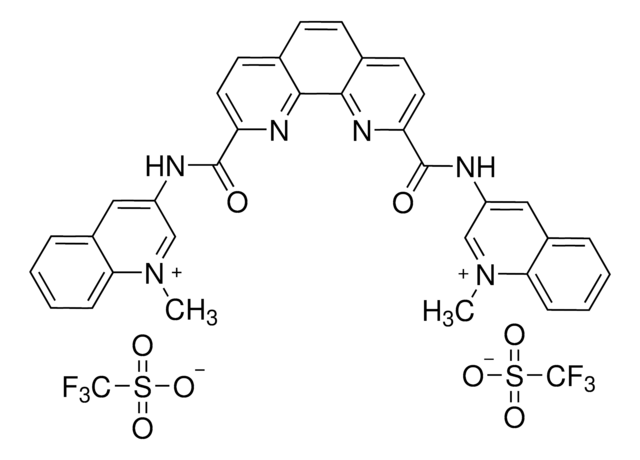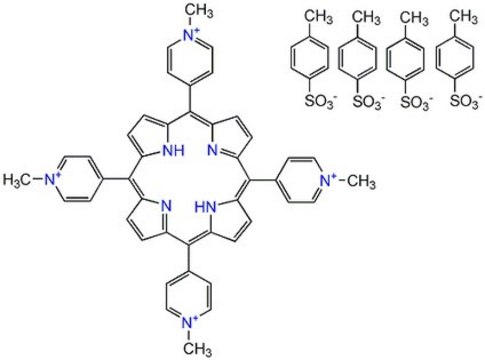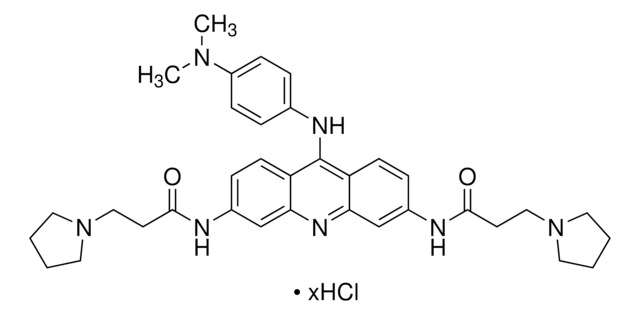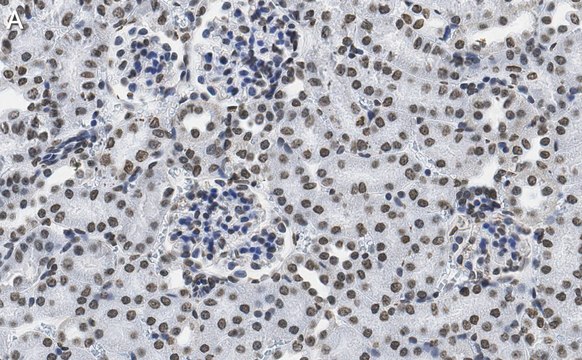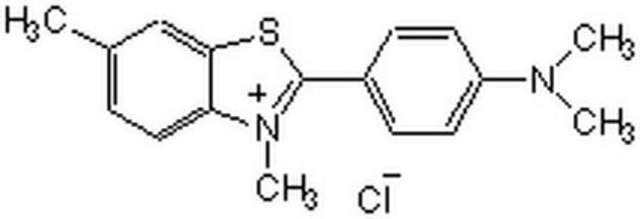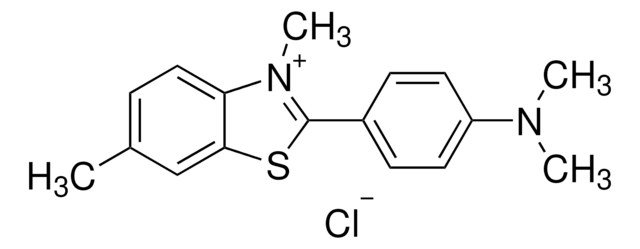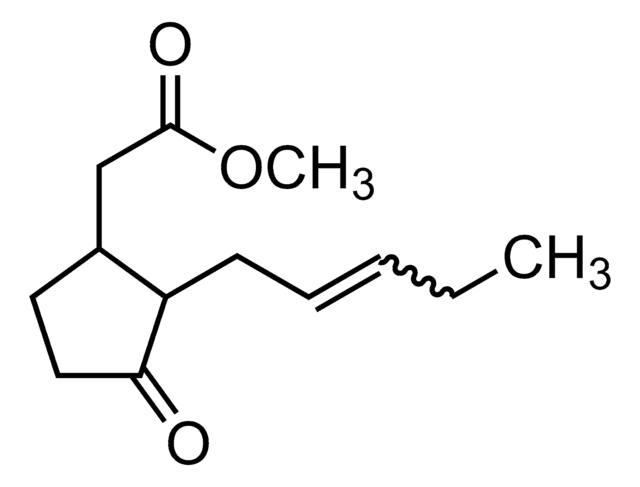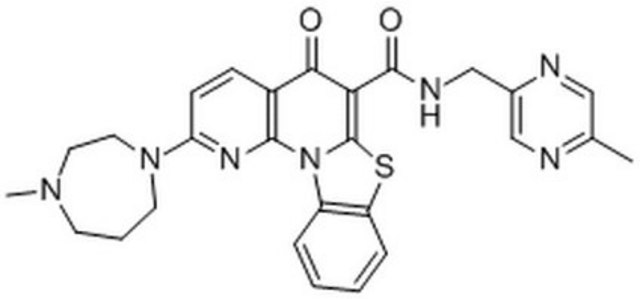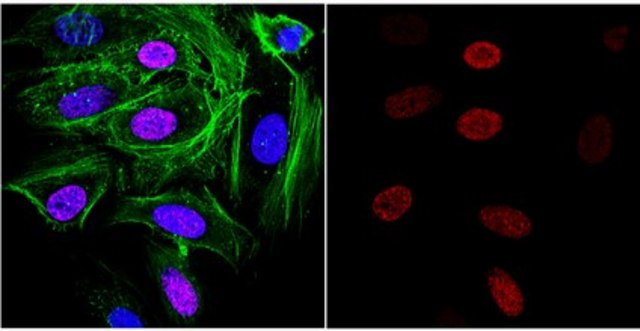SML2690
Pyridostatin hydrochloride
≥98% (HPLC), powder, G-quadruplex DNA stabilizing agent
别名:
4-(2-Aminoethoxy)-N2,N6-bis(4-(2-aminoethoxy)quinolin-2-yl)pyridine-2,6-dicarboxamide hydrochloride, 4-(2-Aminoethoxy)-N2,N6-bis[4-(2-aminoethoxy)-2-quinolinyl]-2,6-pyridinedicarboxamide hydrochloride, RR 82 HCl, RR-82 HCl, RR82 HCl
登录查看公司和协议定价
所有图片(1)
About This Item
经验公式(希尔记法):
C31H32N8O5 · xHCl
分子量:
596.64 (free base basis)
MDL编号:
UNSPSC代码:
12352200
NACRES:
NA.77
推荐产品
产品名称
Pyridostatin hydrochloride, ≥98% (HPLC)
方案
≥98% (HPLC)
表单
powder
储存条件
desiccated
颜色
white to beige
溶解性
DMSO: 2 mg/mL, clear
储存温度
2-8°C
SMILES字符串
NCCOc1cc(nc(c1)C(=O)Nc4nc5c(c(c4)OCCN)cccc5)C(=O)Nc2nc3c(c(c2)OCCN)cccc3
InChI key
VGHSATQVJCTKEF-UHFFFAOYSA-N
应用
Pyridostatin hydrochloride has been used as a G-quadruplex (G4)-stabilizing ligand to check the effect of G4s on fork progression. It has also been used as a G4-stabilizing ligand to study the effect of G4 on apurinic/apyrimidinic endonuclease 1 (APE1) mediated Kirsten rat sarcoma virus (KRAS) expression in pancreatic ductal adenocarcinoma (PDAC) cell lines.
生化/生理作用
Pyridostatin is a highly selective G-quadruplex (G4) interacting molecule. It retards the growth of human cancer cells by inducing replication/transcription dependent on DNA damage. Pyridostatin stabilizes G-quadruplexes, targeting the proto-oncogene SRC and telomeric G4, inducing DNA damage and cell-cycle arrest.
Stabilizer of G-quadruplexes (G4).
储存分类代码
11 - Combustible Solids
WGK
WGK 3
闪点(°F)
Not applicable
闪点(°C)
Not applicable
法规信息
新产品
历史批次信息供参考:
分析证书(COA)
Lot/Batch Number
Kaitlin Johnson et al.
RNA (New York, N.Y.), 30(9), 1213-1226 (2024-06-26)
Telomere replication is essential for continued proliferation of human cells, such as stem cells and cancer cells. Telomerase lengthens the telomeric G-strand, while C-strand replication is accomplished by CST-polymerase α-primase (CST-PP). Replication of both strands is inhibited by formation of
Hong-Liang Bao et al.
Nature protocols, 13(4), 652-665 (2018-03-09)
Growing evidence indicates that RNA G-quadruplexes have important roles in various processes such as transcription, translation, regulation of telomere length, and formation of telomeric heterochromatin. Investigation of RNA G-quadruplex structures associated with biological events is therefore essential to understanding the
Alessio De Magis et al.
Proceedings of the National Academy of Sciences of the United States of America, 116(3), 816-825 (2018-12-29)
G quadruplexes (G4s) and R loops are noncanonical DNA structures that can regulate basic nuclear processes and trigger DNA damage, genome instability, and cell killing. By different technical approaches, we here establish that specific G4 ligands stabilize G4s and simultaneously
Charanya Kumar et al.
eLife, 10 (2021-09-09)
R-loops are a major source of genome instability associated with transcription-induced replication stress. However, how R-loops inherently impact replication fork progression is not understood. Here, we characterize R-loop-replisome collisions using a fully reconstituted eukaryotic DNA replication system. We find that
Suravi Pramanik et al.
Nucleic acids research, 50(6), 3394-3412 (2022-03-15)
Pancreatic ductal adenocarcinoma (PDAC), one of the most aggressive types of cancer, is characterized by aberrant activity of oncogenic KRAS. A nuclease-hypersensitive GC-rich region in KRAS promoter can fold into a four-stranded DNA secondary structure called G-quadruplex (G4), known to
我们的科学家团队拥有各种研究领域经验,包括生命科学、材料科学、化学合成、色谱、分析及许多其他领域.
联系技术服务部门